Correlation Analysis between Hydrologic Flow Metrics and Benthic Macroinvertebrates Index (BMI) in the Han River Basin, South Korea
Abstract
1. Introduction
2. Materials and Methods
2.1. Study Area
2.2. Description of Hydrological Flow Metrics
2.3. Benthic Macroinvertebrates Index (BMI)
2.4. Pearson’s Correlation Coefficient Analysis
3. Results
3.1. Calculation Results of Flow Metrics
3.2. Correlation Analysis between Hydrological Compoenet and BMI
3.2.1. Relationship between Imperviousness and BMI
3.2.2. Correlation Analysis between Flow Metrics and BMI
4. Discussion
5. Conclusions
Author Contributions
Funding
Institutional Review Board Statement
Informed Consent Statement
Data Availability Statement
Acknowledgments
Conflicts of Interest
References
- Booth, D.B.; Jackson, C.R. Urbanization of Aquatic Systems: Degradation Thresholds, Stormwater Detection, and the Limits of Mitigation. J. Am. Water Resour. Assoc. 1997, 33, 1077–1090. [Google Scholar] [CrossRef]
- Meyer, J.L. Stream Health: Incorporating the Human Dimension to Advance Stream Ecology. J. N. Am. Benthol. Soc. 1997, 16, 439–447. [Google Scholar] [CrossRef]
- Paul, M.J.; Meyer, J.L. Streams in the urban landscape. Annu. Rev. Ecol. Syst. 2001, 32, 333–365. [Google Scholar] [CrossRef]
- Konrad, C.P.; Booth, D.B. Hydrologic Changes in Urban Streams and their Ecological Significance. Am. Fish. Soc. Symp. 2005, 47, 17. [Google Scholar]
- Roy, A.H.; Freeman, M.C.; Freeman, B.J.; Wenger, S.J.; Ensign, W.E.; Meyer, J.L. Investigating Hydrologic Alteration as a Mechanism of Fish Assemblage Shifts in Urbanizing Streams. J. N. Am. Benthol. Soc. 2005, 24, 656–678. [Google Scholar] [CrossRef]
- Putnam, A.L. Effect of Urban Development on Floods in the Piedmont Province of North Carolina; US Geological Survey: Raleigh, NC, USA, 1972.
- Johnson, S.L.; Sayre, D.M. Effects of Urbanization on Floods in the Houston Texas Metropolitan Area; US Geological Survey, Water Resources Division: Austin, TX, USA, 1973; Volume 3.
- Shuster, W.D.; Bonta, J.; Thurston, H.; Warnemuende, E.; Smith, D.R. Impacts of Impervious Surface on Watershed Hydrology: A Review. Urban Water J. 2005, 2, 263–275. [Google Scholar] [CrossRef]
- Sheeder, S.A.; Ross, J.D.; Carlson, T.N. Dual urban and rural hydrograph signals in three small watersheds 1. JAWRA J. Am. Water Resour. Assoc. 2002, 38, 1027–1040. [Google Scholar] [CrossRef]
- Woo, S.Y.; Jung, C.G.; Lee, J.W.; Kim, S.J. Evaluation of Watershed Scale Aquatic Ecosystem Health by SWAT Modeling and Random Forest Technique. Sustainability 2019, 11, 3397. [Google Scholar] [CrossRef]
- Lee, J.; Lee, S.; An, K.; Hwang, S.; Kim, N. An Estimated Structural Equation Model to Assess the Effects of Land use on Water Quality and Benthic Macroinvertebrates in Streams of the Nam-Han River System, South Korea. Int. J. Environ. Res. Public Health 2020, 17, 2116. [Google Scholar] [CrossRef]
- Kim, M.; Lee, S. Regression Tree Analysis for Stream Biological Indicators Considering Spatial Autocorrelation. Int. J. Environ. Res. Public Health 2021, 18, 5150. [Google Scholar] [CrossRef]
- Ministry of Environment. Nationwide Aquatic Ecological Monitoring Program; National Institute of Environmental Research: Incheon, Korea, 2014; pp. 42–61.
- Olden, J.D.; Poff, N.L. Redundancy and the Choice of Hydrologic Indices for Characterizing Streamflow Regimes. River Res. Appl. 2003, 19, 101–121. [Google Scholar] [CrossRef]
- Richter, B.D.; Baumgartner, J.V.; Powell, J.; Braun, D.P. A Method for Assessing Hydrologic Alteration within Ecosystems. Conserv. Biol. 1996, 10, 1163–1174. [Google Scholar] [CrossRef]
- Poff, N.L.; Allan, J.D. Functional Organization of Stream Fish Assemblages in Relation to Hydrological Variability. Ecology 1995, 76, 606–627. [Google Scholar] [CrossRef]
- Clausen, B.; Biggs, B.J.F. Flow Variables for Ecological Studies in Temperate Streams: Groupings Based on Covariance. J. Hydrol. 2000, 237, 184–197. [Google Scholar] [CrossRef]
- Booth, D.B.; Karr, J.R.; Schauman, S.; Konrad, C.P.; Morley, S.A.; Larson, M.G.; Burges, S.J. Reviving Urban Streams: Land use, Hydrology, Biology, and Human Behavior. J. Am. Water Resour. Assoc. 2004, 40, 1351–1364. [Google Scholar] [CrossRef]
- Park, S.; Hwang, S.; An, K.; Lee, S. Identifying Key Watershed Characteristics that Affect the Biological Integrity of Streams in the Han River Watershed, Korea. Sustainability 2021, 13, 3359. [Google Scholar] [CrossRef]
- Woo, S.Y.; Kim, S.J.; Hwang, S.J.; Jung, C.G. Assessment of changes on water quality and aquatic ecosystem health in Han River basin by additional dam release of stream maintenance flow. J. Korea Water Resour. Assoc. 2019, 52, 777–789. [Google Scholar]
- Go, W.S.; Yoon, C.G.; Rhee, H.P.; Hwang, S.J.; Lee, S.W. A Study on the prediction of BMI (Benthic Macroinvertebrate Index) using Machine Learning Based CFS(Correlation-based Feature Selection) and Random Forest Model. J. Korean Soc. Water Environ. 2019, 35, 425–431. [Google Scholar]
- Patrick, C.J.; Yuan, L.L. Modeled Hydrologic Metrics show Links between Hydrology and the Functional Composition of Stream Assemblages. Ecol. Appl. 2017, 27, 1605–1617. [Google Scholar] [CrossRef] [PubMed]
- Ahn, S.; Kim, S. Assessment of Watershed Health, Vulnerability and Resilience for Determining Protection and Restoration Priorities. Environ. Model. Amp Softw. Environ. Data News 2019, 122, 103926. [Google Scholar] [CrossRef]
- Jung, C.; Lee, J.; Lee, Y.; Kim, S. Quantification of Stream Drying Phenomena Using Grid-Based Hydrological Modeling via Long-Term Data Mining throughout South Korea including Ungauged Areas. Water 2019, 11, 477. [Google Scholar] [CrossRef]
- Jung, C.G.; Moon, J.W.; Jang, C.H.; Lee, D.R. Assessment of Climate Change Impacts on Hydrology and Snowmelt by Applying RCP Scenarios using SWAT Model for Han River Watersheds. J. Korean Soc. Agric. Eng. 2013, 55, 37–48. [Google Scholar]
- Richter, B.D.; Baumgartner, J.V.; Wigington, R.; Braun, D.P. How Much Water does a River Need? Freshw. Biol. 1997, 37, 231–249. [Google Scholar] [CrossRef]
- Richter, B.D.; Baumgartner, J.V.; Braun, D.P.; Powell, J. A Spatial Assessment of Hydrologic Alteration within a River Network. Regul. Rivers Res. Mgmt 1998, 14, 329–340. [Google Scholar] [CrossRef]
- Wood, P.J.; Agnew, M.D.; Petts, G.E. Flow Variations and Macroinvertebrate Community Responses in a Small Groundwater-Dominated Stream in South-East England. Hydrol. Process. 2000, 14, 3133–3147. [Google Scholar] [CrossRef]
- Puckridge, J.T.; Sheldon, F.; Walker, K.F.; Boulton, A.J. Flow Variability and the Ecology of Large Rivers. Mar. Freshw. Res. 1998, 49, 55–72. [Google Scholar] [CrossRef]
- Hughes, J.; James, B. A Hydrological Regionalization of Streams in Victoria, Australia, with Implications for Stream Ecology. Mar. Freshw. Res. 1989, 40, 303–326. [Google Scholar] [CrossRef]
- Clausen, B.; Biggs, B.J.F. Relationships between Benthic Biota and Hydrological Indices in New Zealand Streams. Freshw. Biol. 1997, 38, 327–342. [Google Scholar] [CrossRef]
- Park, S.D. Dimensionless flow Duration Curve in Natural River. J. Korea Water Resour. Assoc. 2003, 36, 33–44. [Google Scholar] [CrossRef]
- Lee, T.H.; Lee, M.H.; Yi, J. Development of Regional Regression Model for Estimating Flow Duration Curves in Ungauged Basins. KSCE J. Civ. Environ. Eng. Res. 2016, 36, 427–437. [Google Scholar]
- Kim, Y.W.; Lee, J.W.; Kim, S.J. Analysis of extreme cases of climate change impact on watershed hydrology and flow duration in Geum river basin using SWAT and STARDEX. J. Korea Water Resour. Assoc. 2018, 51, 905–916. [Google Scholar]
- Kong, D.; Son, S.H.; Hwang, S.J.; Won, D.H.; Kim, M.C.; Park, J.H.; Jeon, T.S.; Lee, J.E.; Kim, J.H.; Kim, J.S.; et al. Development of Benthic Macroinvertebrates Index (BMI) for Biological Assessment on Stream Environment. J. Korean Soc. Water Environ. 2018, 34, 183–201. [Google Scholar]
- Zelinka, M. Zur Prazisierung der biologischen klassifikation der Reinheid fliessender Gewasser. Arch. Hydrobiol. 1961, 57, 389–407. [Google Scholar]
- Ministry of Environment. Nationwide Aquatic Ecological Monitoring Program; National Institute of Environmental Research: Incheon, Korea, 2012; pp. 43–62.
- Lee Rodgers, J.; Nicewander, W.A. Thirteen Ways to Look at the Correlation Coefficient. Am. Stat. 1988, 42, 59–66. [Google Scholar] [CrossRef]
- Moriasi, D.N.; Arnold, J.G.; Van Liew, M.W.; Bingner, R.L.; Harmel, R.D.; Veith, T.L. Model Evaluation Guidelines for Systematic Quantification of Accuracy in Watershed Simulations. Trans. ASABE 2007, 50, 885–900. [Google Scholar] [CrossRef]
- Zhou, H.; Deng, Z.; Xia, Y.; Fu, M. A New Sampling Method in Particle Filter Based on Pearson Correlation Coefficient. Neurocomputing 2016, 216, 208–215. [Google Scholar] [CrossRef]
- Kumari, N.; Srivastava, A.; Sahoo, B.; Raghuwanshi, N.S.; Bretreger, D. Identification of Suitable Hydrological Models for Streamflow Assessment in the Kangsabati River Basin, India, by using Different Model Selection Scores. Nat. Resour. Res. 2021, 1–19. [Google Scholar] [CrossRef]
- Walsh, C.J.; Roy, A.H.; Feminella, J.W.; Cottingham, P.D.; Groffman, P.M.; Morgan, R.P. The Urban Stream Syndrome: Current Knowledge and the Search for a Cure. J. N. Am. Benthol. Soc. 2005, 24, 706–723. [Google Scholar] [CrossRef]
- Dehghan, S.; Salehnia, N.; Sayari, N.; Bakhtiari, B. Prediction of Meteorological Drought in Arid and Semi-Arid Regions using PDSI and SDSM: A Case Study in Fars Province, Iran. J. Arid Land 2020, 12, 318–330. [Google Scholar] [CrossRef]
- Choi, J.; Kim, S. Responses of Rotifer Community to Microhabitat Changes Caused by Summer-Concentrated Rainfall in a Shallow Reservoir, South Korea. Diversity 2020, 12, 113. [Google Scholar] [CrossRef]
- Choi, J.; Jeong, K.; La, G.; Kim, H.; Chang, K.; Joo, G. Inter-Annual Variability of a Zooplankton Community: The Importance of Summer Concentrated Rainfall in a Regulated River Ecosystem. J. Ecol. Field Biol. 2011, 34, 49–58. [Google Scholar] [CrossRef][Green Version]
- Jeong, K.; Kim, D.; Joo, G. Delayed Influence of Dam Storage and Discharge on the Determination of Seasonal Proliferations of Microcystis Aeruginosa and Stephanodiscus Hantzschii in a Regulated River System of the Lower Nakdong River (South Korea). Water Res. 2007, 41, 1269–1279. [Google Scholar] [CrossRef]
- Jung, I.W.; Bae, D.H.; Lee, B.J. Possible Change in Korean Streamflow Seasonality Based on Multi-Model Climate Projections. Hydrol. Process. 2013, 27, 1033–1045. [Google Scholar] [CrossRef]
- Kennen, J.G.; Riva-Murray, K.; Beaulieu, K.M. Determining Hydrologic Factors that Influence Stream Macroinvertebrate Assemblages in the Northeastern US. Ecohydrology 2010, 3, 88–106. [Google Scholar] [CrossRef]
- Burns, M.J.; Walsh, C.J.; Fletcher, T.D.; Ladson, A.R.; Hatt, B.E. A Landscape Measure of Urban Stormwater Runoff Effects is a Better Predictor of Stream Condition than a Suite of Hydrologic Factors. Ecohydrology 2015, 8, 160–171. [Google Scholar] [CrossRef]
- Hamel, P.; Daly, E.; Fletcher, T.D. Which Baseflow Metrics should be used in Assessing Flow Regimes of Urban Streams? Hydrol. Process. 2015, 29, 4367–4378. [Google Scholar] [CrossRef]
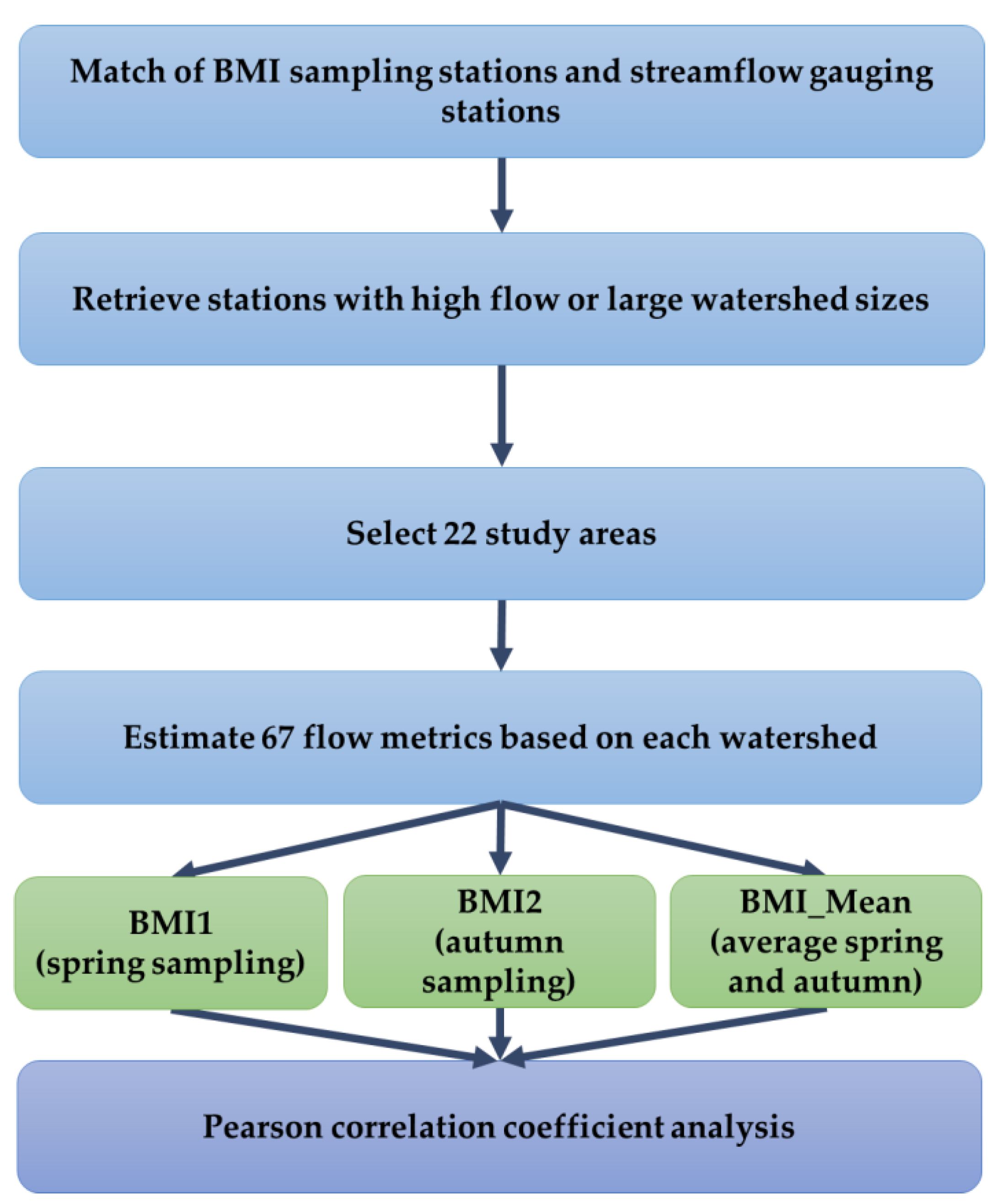
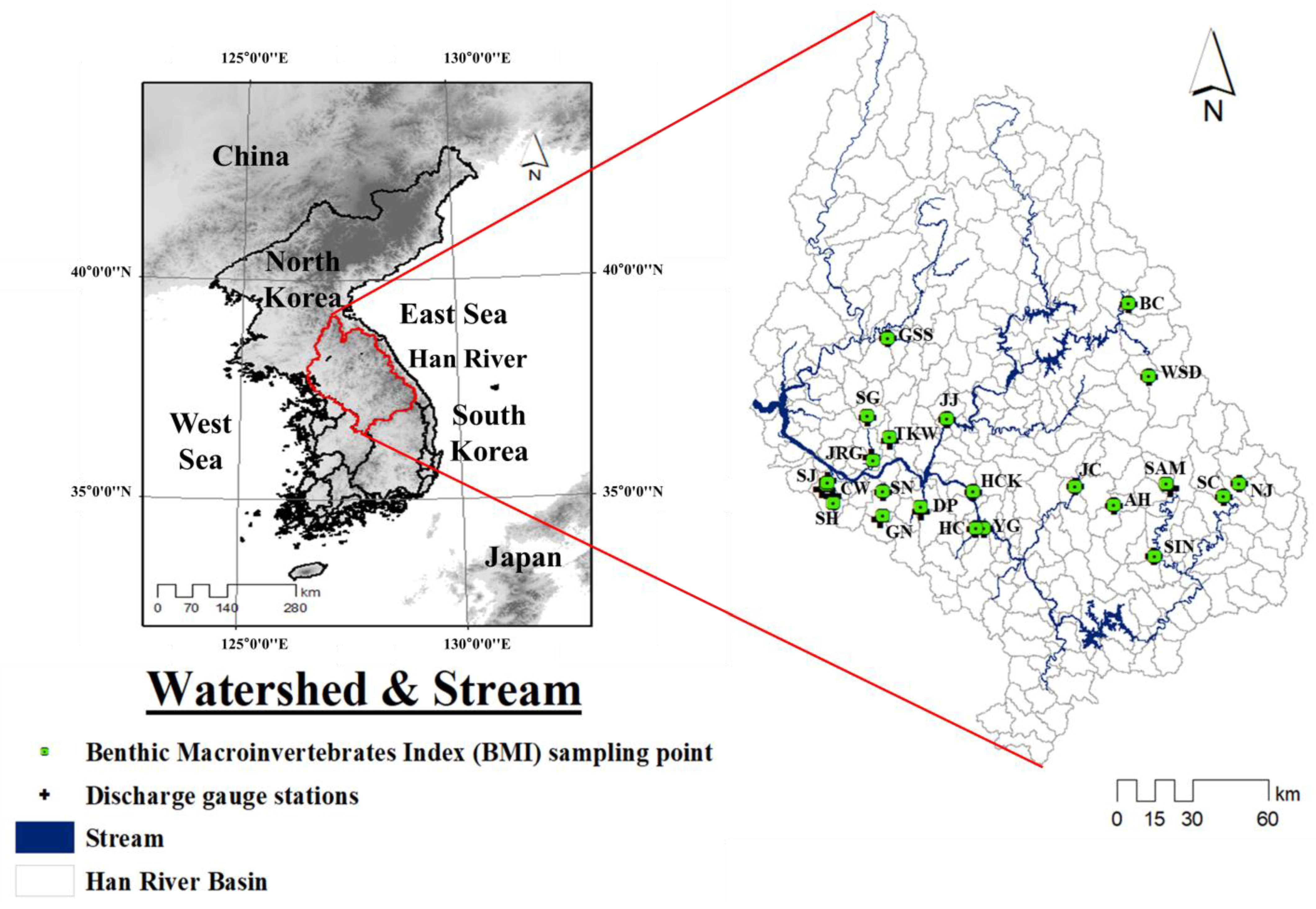
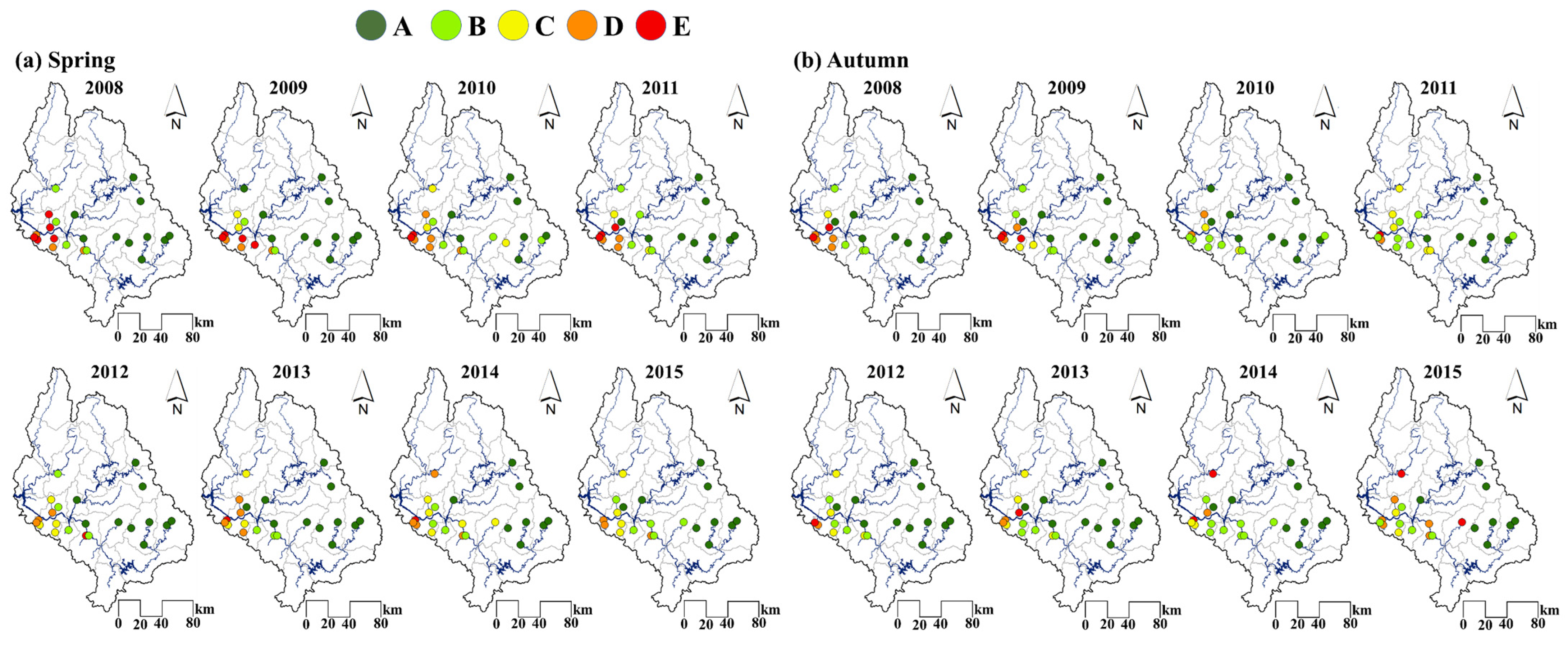

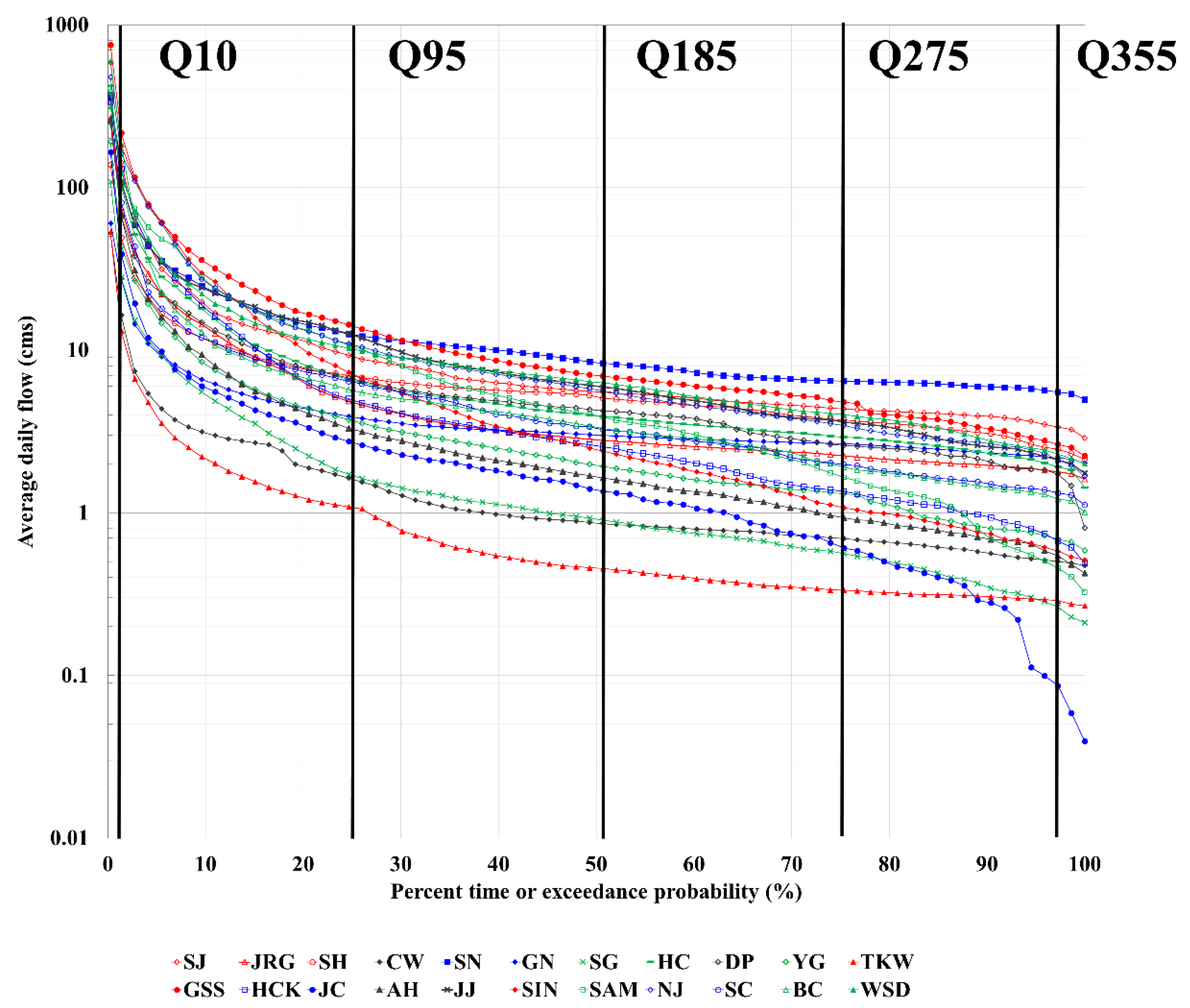

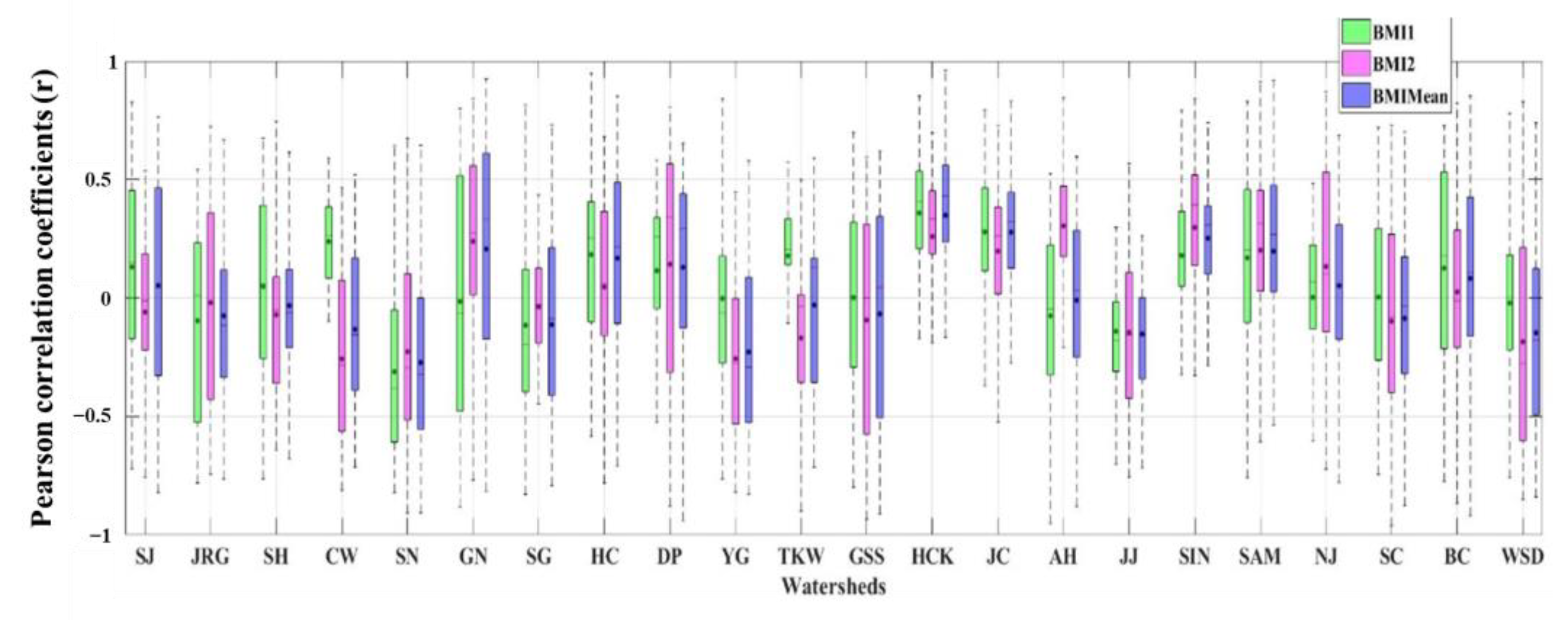

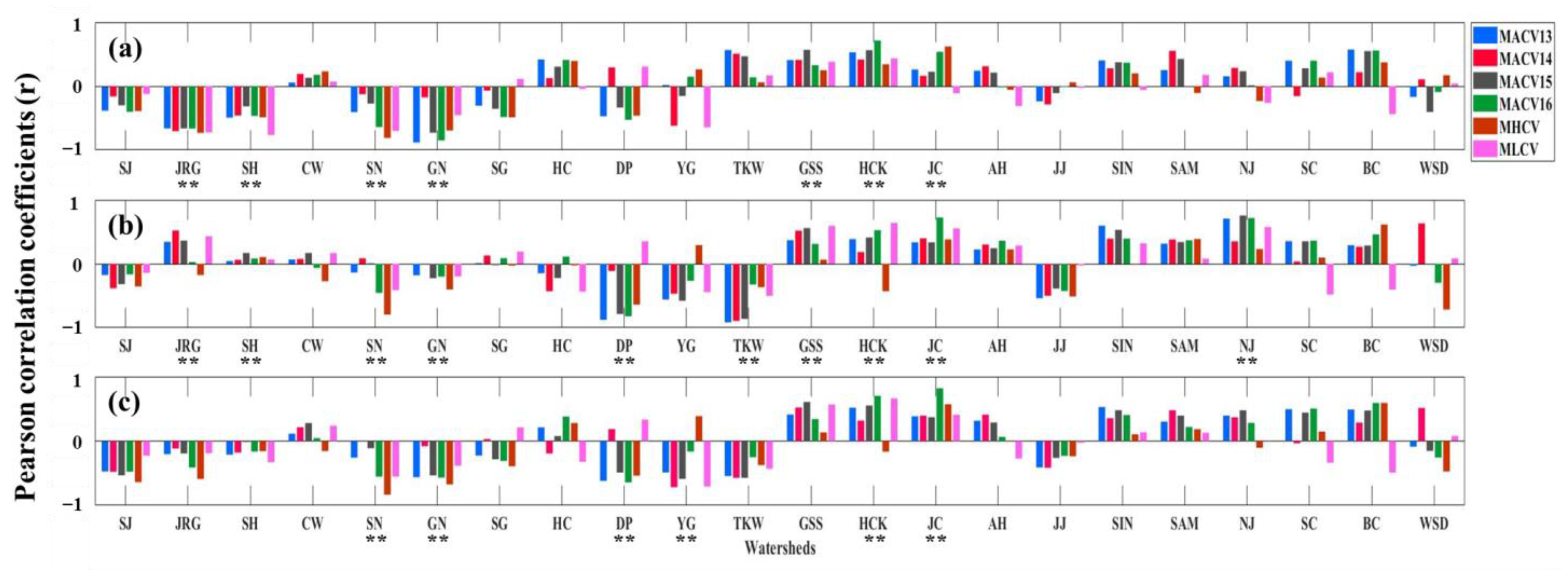
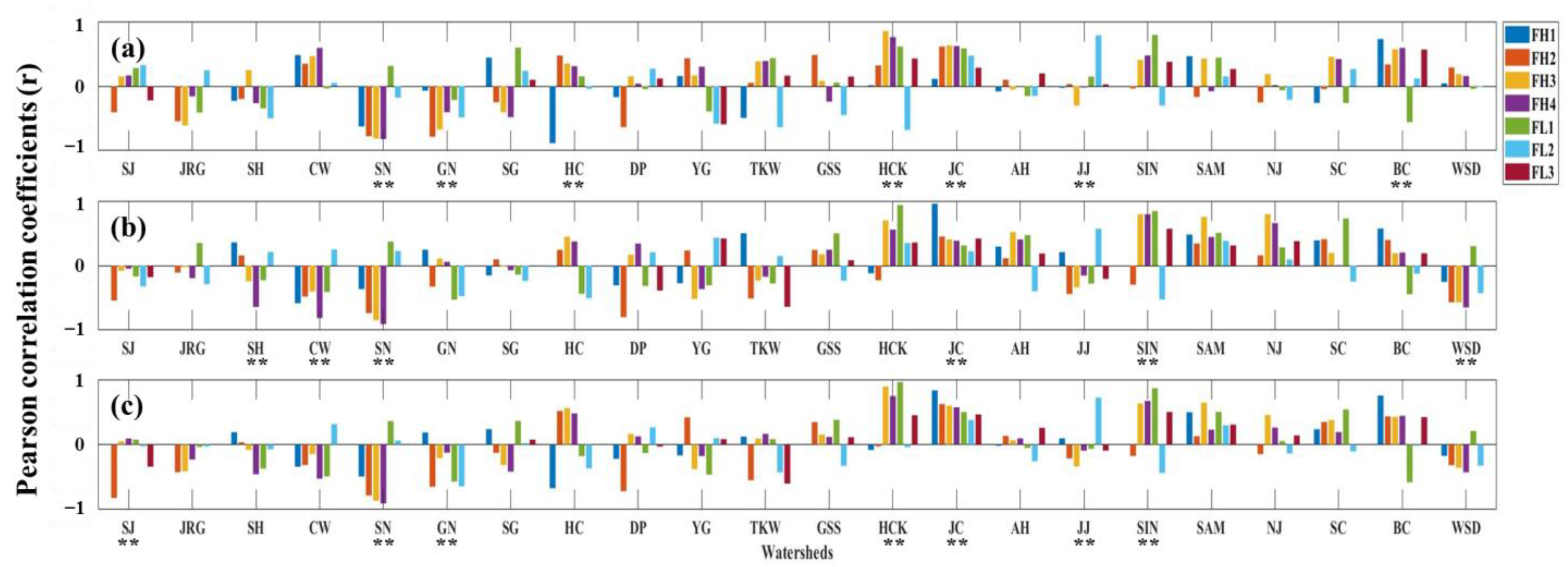

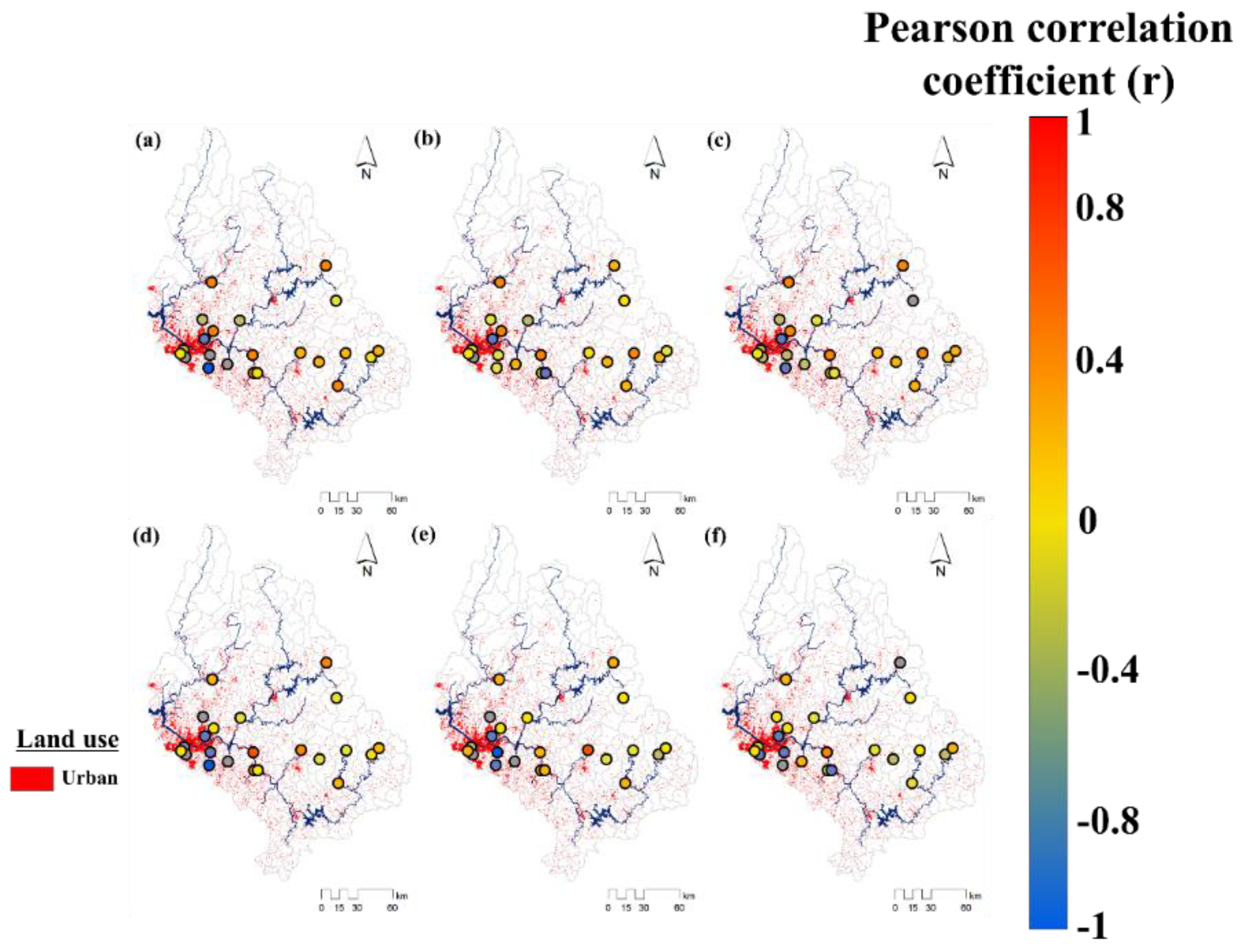
| Watersheds | Flow | Total Area (km2) | Land-Use (km2) | Imperviousness (%) | ||||||
|---|---|---|---|---|---|---|---|---|---|---|
| Urban | Agriculture | Forest | Grassland | Wetland | Bare Land | Water | ||||
| Sinjeong (SJ) | O | 217.52 | 84.46 | 31.51 | 89.34 | 3.16 | 0.04 | 5.85 | 3.16 | 38.83 |
| Jungranggyo (JRG) | O | 233.51 | 80.06 | 21.62 | 116.23 | 3.78 | 0.23 | 8.85 | 2.72 | 34.29 |
| Sihueng (SH) | O | 126.75 | 41.92 | 16.03 | 61.10 | 2.23 | 0.01 | 4.08 | 1.39 | 33.07 |
| Cheonwang (CW) | C | 43.68 | 14.25 | 12.89 | 14.54 | 0.39 | 0.00 | 0.47 | 1.14 | 32.62 |
| Seongnam (SN) | O | 203.81 | 53.75 | 24.10 | 107.89 | 4.53 | 1.24 | 9.83 | 2.46 | 26.37 |
| Gungnae (GN) | C | 100.99 | 24.78 | 9.56 | 55.84 | 2.37 | 0.17 | 6.66 | 1.60 | 24.54 |
| Singok (SG) | O | 84.24 | 14.63 | 16.40 | 47.92 | 1.37 | 0.03 | 3.04 | 0.85 | 17.37 |
| Heungcheon (HC) | C | 309.42 | 30.93 | 135.81 | 125.17 | 6.61 | 2.01 | 3.20 | 5.70 | 10.00 |
| Dopyeong (DP) | C | 158.47 | 15.51 | 27.59 | 105.95 | 3.61 | 0.14 | 3.05 | 2.61 | 9.79 |
| Yulgeuk (YG) | C | 181.11 | 14.43 | 111.45 | 44.39 | 3.15 | 1.13 | 2.84 | 3.71 | 7.97 |
| Toegyewon (TKW) | C | 201.45 | 13.76 | 37.43 | 138.48 | 6.12 | 0.00 | 2.74 | 2.83 | 6.83 |
| Gososung (GSS) | C | 569.19 | 35.97 | 123.05 | 377.44 | 15.87 | 0.14 | 7.36 | 9.37 | 6.32 |
| Heukcheonkyo (HCK) | C | 314.00 | 13.08 | 56.73 | 233.35 | 3.72 | 1.25 | 2.70 | 3.18 | 4.16 |
| Jeoncheon (JC) | C | 170.69 | 5.38 | 28.58 | 132.99 | 1.12 | 0.42 | 1.05 | 1.16 | 3.15 |
| Anheung (AH) | C | 123.94 | 2.81 | 31.12 | 87.03 | 0.77 | 0.12 | 1.77 | 0.32 | 2.27 |
| Jojong (JJ) | C | 260.51 | 5.57 | 29.86 | 214.26 | 4.60 | 0.05 | 1.12 | 5.06 | 2.14 |
| Sincheon (SIN) | C | 607.21 | 7.73 | 86.45 | 499.47 | 2.12 | 1.42 | 5.47 | 4.56 | 1.27 |
| Sanganmi (SAM) | C | 402.37 | 4.34 | 40.40 | 350.71 | 2.57 | 0.14 | 2.30 | 1.91 | 1.08 |
| Najeon (NJ) | C | 451.59 | 4.67 | 33.25 | 407.21 | 1.96 | 1.85 | 1.09 | 1.56 | 1.03 |
| Songcheon (SC) | C | 352.02 | 3.55 | 62.68 | 276.42 | 3.80 | 0.47 | 1.96 | 3.14 | 1.01 |
| Bukcheon (BC) | C | 304.05 | 2.62 | 9.86 | 287.67 | 0.46 | 0.93 | 1.30 | 1.21 | 0.86 |
| Wangsungdong (WSD) | C | 403.38 | 1.34 | 20.93 | 376.26 | 2.12 | 0.06 | 0.85 | 1.84 | 0.33 |
| Variables | Hydrologic Index | Definition | Reference | Calculation | Unit | |
|---|---|---|---|---|---|---|
| Magnitude | MA1-12 | Mean monthly daily flow (January–December) | Mean monthly flow for all months | [15,17,26,27,28] | - | m3/s |
| MASW | Skewness in monthly flow | (Mean monthly flow–median monthly flow)/median monthly flow | [29] | SW = (mean monthly flow − median monthly flow)/median monthly flow | Dimensionless | |
| MACV1-12 | Variability in monthly flow (January–December) | Coefficient of variation for monthly flow for all months | [15,17,26,27] | Dimensionless | ||
| MACV13-15 | Variability across monthly flow 1 | Variability in monthly flow divided by median monthly flow, where variability is calculated as range (max monthly flow − min monthly flow), interquartile (75th monthly flow − 25th monthly flow), and 90th − 10th percentile (90th monthly flow − 10th monthly flow) | [29] | ranges = max monthly flow − min monthly flow interquartile = 75th monthly flow − 25th monthly flow 90th − 10th percentile = 90th monthly flow − 10th monthly flow | Dimensionless | |
| MACV16 | Variability across monthly flow 2 | Coefficient of variation for mean monthly flow | [30] | Dimensionless | ||
| MH1-12 | Maximum daily flow (January–December) | Maximum daily flow for all months | [28] | - | ||
| MHCV | Variability across maximum daily flow | Coefficient of variation for maximum daily flow | [30] | Dimensionless | ||
| ML1-12 | Minimum daily flow (January–December) | Minimum daily flow for all months | [28] | - | ||
| MLCV | Variability across minimum daily flow | Coefficient of variation for minimum daily flow | [30] | Dimensionless | ||
| Frequency | FL1 | Low flood pulse count | Number of annual occurrences during which the magnitude of flow remains below a lower threshold. Hydrologic pulses are defined as those periods within a year in which the flow drops below the 25th percentile (low pulse) of all daily values for the time period. | [15,26,27] | Daily flow < 25th percentile daily flow Count days of daily flow that do not exceed the 25th daily flows. | Dimensionless |
| FL2 | Variability in low flood pulse count | Coefficient of variation for FL1 | [15,26,27] | Dimensionless | ||
| FL3 | Frequency of flow spells | Total number of low flow spells (threshold equal to 5% of mean daily flow) divided by the record length in years | [30] | Daily flow < threshold 5% daily flow Count days of daily flow that do not exceed the threshold 5% daily flow. | Dimensionless | |
| FH1 | High flood pulse count 1 | See FL1, where the high pulse is defined as the 75th percentile | [15,26,27] | Daily flow > 75th percentile daily flow Count days of daily flow that exceed the 75th daily flows. | Dimensionless | |
| FH2 | Variability in high flood pulse count 1 | Coefficient of variation for FH1 | [15,26,27] | Dimensionless | ||
| FH3 | High flood pulse count 2 | See FH1, where the upper threshold is defined as 3 median daily flow, and the value is represented as an average instead of a tabulated count | [17,31] | Daily flow > Find the daily flow values that are greater than 3 times the daily median and sum all those flow values. Count days of daily flow that exceed the . | ||
| FH4 | High flood pulse count 2 | See FH1, where the upper threshold is defined as 7 times median daily flow, and the value is represented as an average instead of a tabulated count | [17,31] | Daily flow > 7 Find the daily flow values that are greater than 7times the daily median and sum all those flow values. Count days of daily flow that exceed the 7. | ||
| Design | Q10, Q95, Q185, Q275, Q355 | Designed flow used in river planning and design | After sorting the daily flow of the year in descending order, the daily flow of the 10th, 95th, 185th, 275th, and 355th days was extracted | [32,33,34] | - | |
| Range | Class | Condition |
|---|---|---|
| A | Very Good | |
| B | Good | |
| C | Fair | |
| D | Poor | |
| E | Very poor |
Publisher’s Note: MDPI stays neutral with regard to jurisdictional claims in published maps and institutional affiliations. |
© 2021 by the authors. Licensee MDPI, Basel, Switzerland. This article is an open access article distributed under the terms and conditions of the Creative Commons Attribution (CC BY) license (https://creativecommons.org/licenses/by/4.0/).
Share and Cite
Kim, S.; Lee, J.; Jeon, S.; Lee, M.; An, H.; Jung, K.; Kim, S.; Park, D. Correlation Analysis between Hydrologic Flow Metrics and Benthic Macroinvertebrates Index (BMI) in the Han River Basin, South Korea. Sustainability 2021, 13, 11477. https://doi.org/10.3390/su132011477
Kim S, Lee J, Jeon S, Lee M, An H, Jung K, Kim S, Park D. Correlation Analysis between Hydrologic Flow Metrics and Benthic Macroinvertebrates Index (BMI) in the Han River Basin, South Korea. Sustainability. 2021; 13(20):11477. https://doi.org/10.3390/su132011477
Chicago/Turabian StyleKim, Siyeon, Jiwan Lee, Seol Jeon, Moonyoung Lee, Heejin An, Kichul Jung, Seongjoon Kim, and Daeryong Park. 2021. "Correlation Analysis between Hydrologic Flow Metrics and Benthic Macroinvertebrates Index (BMI) in the Han River Basin, South Korea" Sustainability 13, no. 20: 11477. https://doi.org/10.3390/su132011477
APA StyleKim, S., Lee, J., Jeon, S., Lee, M., An, H., Jung, K., Kim, S., & Park, D. (2021). Correlation Analysis between Hydrologic Flow Metrics and Benthic Macroinvertebrates Index (BMI) in the Han River Basin, South Korea. Sustainability, 13(20), 11477. https://doi.org/10.3390/su132011477








